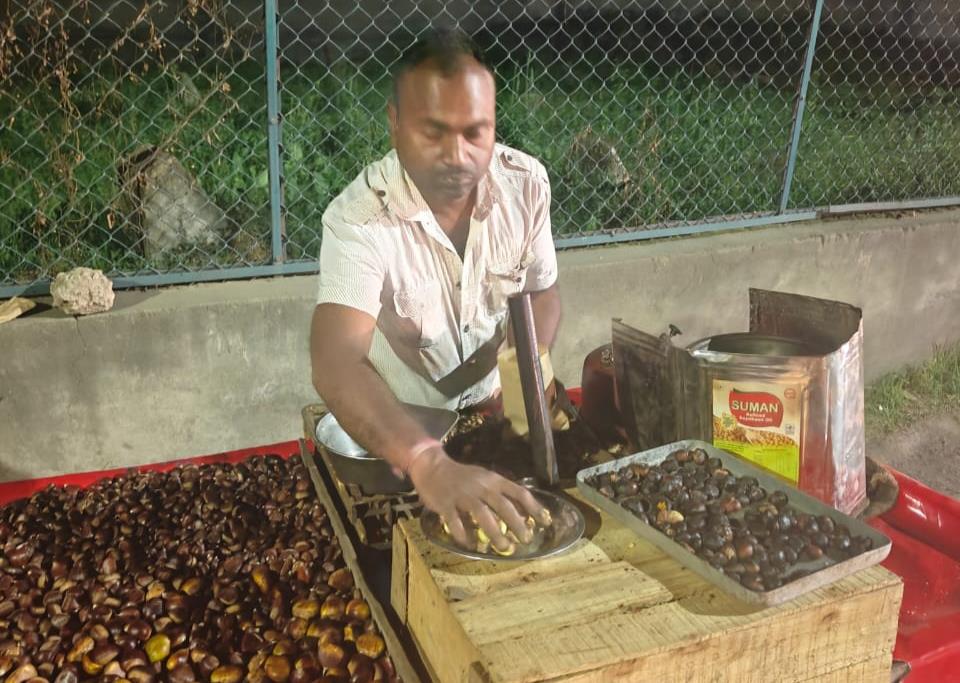What A Bag Of Nuts Taught Me About Kashmir's Street Economy
Non-local chestnut seller in City. KO photo by Irshad Mushtaq
I went out on a crisp autumn afternoon to buy chestnuts and walnuts, expecting nothing more than a quick errand. Srinagar's markets throbbed with their familiar pulse: vendors calling out prices, the scent of roasted corn hanging in the air, and some tourists threading their way through the local crowd.
But the few stops I made told a bigger story about how business is done in Kashmir and why it needs a fresh approach.
The first chestnut seller, a local, weighed out 80 grams for 100 rupees. He spoke of high cleaning costs and superior quality, but the numbers did not add up when other stalls nearby offered 100 grams for the same price.
I paused, and he quickly lowered his offer to avoid losing the sale. The price drop felt less like generosity and more like a hidden margin finally exposed.
Bargaining is part of Kashmiri culture, but it also signals how many vendors start with inflated rates and wait for resistance before revealing a fairer figure.
A few stalls ahead, another chestnut vendor, this one from outside the valley, worked differently. He displayed his prices on a small cardboard sign: 110 grams for 100 rupees, 250 grams for 200. He packed the nuts neatly, pointed to the cleaning process, and even remembered that I had bought from him the week before.
There was no guessing game, no last-minute discount, only a clear pitch and a friendly nod.
The contrast was hard to miss: where one relied on haggling, the other relied on trust.
The walnut stop sharpened the lesson.
The vendor sat scrolling on his phone, barely acknowledging me. After repeated questions he named a steep price, claiming his walnuts were polished and rare. When I mentioned a lower wholesale rate, he stiffened and justified his figure by citing personal financial strain.
His story might have been true, many small traders in Kashmir struggle with high transport costs, unstable tourist seasons and weak credit access, but the approach pushed me away instead of drawing me in.
These brief encounters reveal three habits that hold Kashmiri street markets back.
Customer engagement is the first. A greeting, a bit of recognition, or a simple explanation of quality can turn a casual buyer into a loyal one.
Transparent pricing is the second. Starting high and bargaining down may feel traditional, but it erodes trust and wastes time.
The third is adaptability. Clean packaging, digital payments, and clear signage are small upgrades that can set a stall apart in a crowded bazaar.

Legal Disclaimer:
MENAFN provides the
information “as is” without warranty of any kind. We do not accept
any responsibility or liability for the accuracy, content, images,
videos, licenses, completeness, legality, or reliability of the information
contained in this article. If you have any complaints or copyright
issues related to this article, kindly contact the provider above.
Most popular stories
Market Research

- New Cryptocurrency Mutuum Finance (MUTM) Raises $15.8M As Phase 6 Reaches 40%
- Bydfi Joins Korea Blockchain Week 2025 (KBW2025): Deepening Web3 Engagement
- Yield Basis Nears Mainnet Launch As Curve DAO Votes On Crvusd Proposal
- 0G Labs Launches Aristotle Mainnet With Largest Day-One Ecosystem For Decentralized AI
- Ethereum-Based Defi Crypto Mutuum Finance (MUTM) Raises Over $16 Million With More Than 720M Tokens Sold
- Fintech's Gender Gap In Focus: Drofa Comms' Women Leading The Way Joins Evolvh3r's She Connects At TOKEN2049





















Comments
No comment